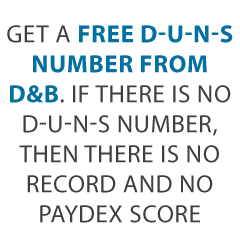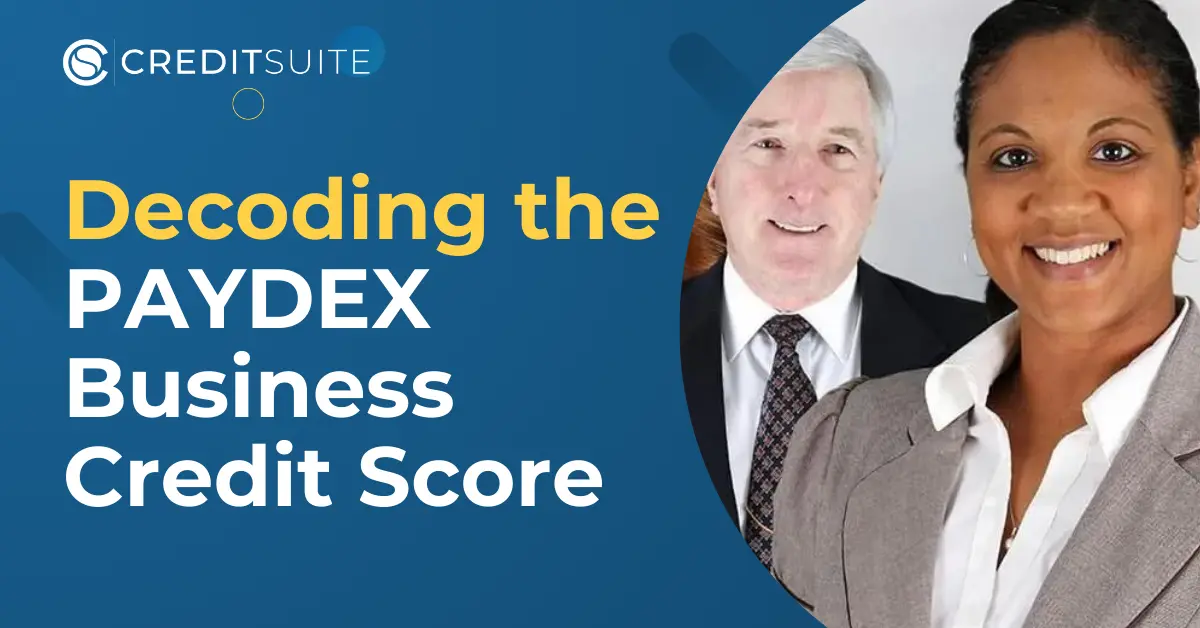What is the PAYDEX Business Credit Score?
Do you have a PAYDEX business credit score, but you’re not sure exactly what went into it, and how to read it? It’s time to start decoding your PAYDEX business credit score.
A PAYDEX business credit score serves as Dun & Bradstreet’s dollar-weighted numerical rating of how a business has paid its bills over the past year. D & B bases their scoring on trade experiences as reported by various vendors. So these can be a business’s landlord, suppliers, etc. It depends on what will apply to your particular circumstances.
PAYDEX Business Credit Score Basics
The Dun & Bradstreet PAYDEX Score is reported in a range running from 1 to 100. As you might expect, higher scores mean a better payment performance.
That is, your business pays its bills on time or early. And it pays them as close to fully as possible. These can keep your PAYDEX score in a better range.
This score comes from payment information which is on report to the bureau. Or it is on report to data-gathering companies partnering with the CRA. See https://creditreports.dnb.com/m/business-glossary/paydex-score.html
D & B uses this information, in addition to a credit score and Financial Stress Score, so as to advise how much credit a lending institution should extend to your business.
Getting Your Business’s First PAYDEX Business Credit Score
To get a PAYDEX score, you need to apply for a D-U-N-S number by way of Dun & Bradstreet’s web site. The number is cost free. In addition the credit reporting agency will need to have records of your payments with four or more vendors.
Your firm’s PAYDEX score reveals if your payments are normally made on time or ahead of schedule. As you might expect, a higher number is better.
The Basis of Your Business’s PAYDEX Business Credit Score
Dun & Bradstreet’s PAYDEX business credit score has a basis in payment details which are reported to the bureau. Or they may be reported to data-gathering businesses partnering with the agency.
D & B uses this data, as well as a credit score and financial stress score, so as to advise just how much credit a creditor should extend to your business.
So to get a PAYDEX number, you have to have a DUNS number, plus the bureau will need to have reports of your payments with four or more vendors. Your business’s PAYDEX score reveals if your payments are typically made on schedule or ahead of schedule. As you might expect, a higher number is better.
D&B Reports and Your PAYDEX Business Credit Score
A Dun & Bradstreet Report (also known as a D&B Report) is a database-generated report. The business services giant generates such a report to help its clients in making decisions regarding new credit applications.
The main reason for a client making use of this kind of a report is to engage in credit risk monitoring of vendors, suppliers, and business partners. This helps companies make informed business credit determinations and steer clear of bad debt.
So Dun & Bradstreet takes many factors into account in generating such a report. These include a predictor of payment delinquency; how financially stressed a company is versus similar businesses; an evaluation of supplier risk; credit limit recommendation; D&B rating; and PAYDEX score. So let’s look at all these factors in turn.
Learn business loan secrets and get money for your business.
Delinquency Predictor
Dun & Bradstreet uses predictive models to ascertain how likely a company is to be overdue with its payments. Predictive scoring is a method of using historical information to attempt to predict future outcomes. It entails identifying the risks inherent in a future decision. It does this by examining the relationship between historical information and the future event.
This is an objective and statistically derived counterpart to subjective and intuitive analyses. Such scoring allows a business to rank and order accounts due to the chance of an event taking place. So that includes delinquent payments. But note that Predictive Scoring only shows a statistical chance, not a guarantee.
Financial Stress Percentile
The Financial Stress Percentile compares the company in question to other businesses in the same region, business sector, amount of employees, or number of years in the business. Financial Stress Score Norms indicate an average score and percentile for all organizations with similar demographic characteristics. D&B uses these norms to benchmark where this particular business versus to the norm for its peer group.
Financial Stress Score
Dun & Bradstreet produces Financial Stress Scores to forecast the likelihood of business failure over the next twelve months.
D&B defines business failure in several ways. One is as a business which gets legal relief from its creditors. Another is a firm which discontinues its business operations without paying off all of its creditors in full. Yet another is a company which voluntarily withdraws from its business operations thus leaving unpaid obligations
Another way is a company which enters into receivership or reorganization. Or it can be a firm which makes some kind of arrangement for the benefit of its creditors. And all of this comes from the data in D&B’s commercial database.
So the score ranges from 1,001 to 1,875. A score of 1,001 is the highest chance. While a figure of 1,875 is the lowest chance of business failure.
If your business has a lot of lawsuits and liens against it, those will negatively impact your financial stress score.
Financial Stress Risk Class
This is a segmentation of the scored universe into five distinct groups, ranging from 1 to 5. A 1 is businesses which have the lowest chance of failure. While a 5 is firms which have the greatest chance of failure.
This Class makes it so a customer can quickly segment their new and existing accounts into various risk segments. This is to identify suitable marketing or credit policies. For any businesses showed as being Discontinued at This Location; Higher Risk; or Open Bankruptcy, those records automatically get a 0 score.
Financial Stress Score Percentile
A Financial Stress Score Percentile is shown as a 1-100 ranking. So a 1 percentile has the highest chance of failure. And a 100 percentile has the lowest chance of failure.
A financially stressed company is a firm with certain characteristics. It may have discontinued operations following assignment of bankruptcy. Or is it has voluntarily withdrawn from business operation leaving unpaid obligations.
Yet another possibility is it has ceased operations with loss to creditors. Or it could be in receivership or reorganization. Or it may have made some sort of an arrangement for the benefit of its creditors.
Supplier Evaluation Risk Rating
The Supplier Evaluation Risk Rating (SER Rating) anticipates how likely it is that a company will get legal relief from its creditors or end its operations without paying creditors in full over next twelve months. The SER rating comes from D&B’s Financial Stress Score. So the Financial Stress Score percentile is the basis for the SER Rating.
Once the Financial Stress Score percentile is determined, a second set of rules are applied to figure the SER Rating. The SER Rating provides a chance of global supplier failure. Local countries’ failure ratings are shown via a Class of 1 – 9. So a 1 is businesses with the lowest chance of supplier failure. A 9 is companies with the highest chance of supplier failure.
https://creditsuite.wistia.com/medias/1rpvzn0f8n?embedType=async&videoFoam=true&videoWidth=640
Credit Limit Recommendation
A D&B Credit Limit Recommendation includes two recommended dollar guidelines:
- A conservative limitation, recommending a dollar benchmark if a company’s policy is to extend less credit to decrease risk and
- An aggressive restriction, suggesting a dollar benchmark if a firm’s policy is to extend more credit with maybe more risk.
These dollar guideline amounts come from on a historical evaluation of the credit demand of customers in the U.S. payments database with a similar profile to the company in question. So this is with respect to employee size and industry. The guidelines do not address if a specific firm can pay that amount or if a certain customer’s total credit limit was met.
Each set of limits comes with an assessment of the risk category a firm falls into. Or it shows D&B’s assessment of how likely they are to continue to pay their obligations within the agreed-upon terms and how likely they are to undergo financial stress in the next twelve months.
D&B Rating
A D&B Rating is meant to help firms quickly check a business’s size and composite credit appraisal. The rating comes from data in a company’s interim or fiscal balance sheet. And it also comes from an overall evaluation of the firm’s creditworthiness.
Rating Classifications
5A to HH Rating Classifications show company size due to worth or equity per Dun & Bradstreet. The figure matters because a business’s size can be an effective indicator of credit capacity. Dun & Bradstreet assigns such ratings to firms which supplied a current financial statement.
Composite Credit Appraisal
This is a number, 1 through 4, and it is the second half of a firm’s rating. It reflects Dun & Bradstreet’s overall assessment of that firm’s creditworthiness. Dun & Bradstreet’s analysis of company payments, financial info, public records, business age and other important factors, when available, are analyzed to generate a Composite Credit Appraisal.
When a company does not provide current financial information, they cannot get a Composite Credit Appraisal rating of better than a 2. Furthermore, the 1R and 2R Rating categories indicate company size due to the total number of employees for the business.
These rating classifications go to company files which do not include a current financial statement. Employee Range (ER) Ratings apply to certain lines of business not lending themselves to classification under the D&B Rating system. These kinds of firms get an Employee Range symbol due to the number of employees only.
In general, when Dun & Bradstreet does not have all of the details they need, they will indicate as much in their reports. However, the omission of some pieces of information does not necessarily mean a specific firm is a poor credit risk.
Learn business loan secrets and get money for your business.
PAYDEX Score
A PAYDEX Score is Dun & Bradstreet’s proprietary dollar-weighted numerical indicator of how a company has paid its bills over the past year. The score comes from trade experiences reported to Dun & Bradstreet by a variety of vendors. In addition, the D&B PAYDEX Score ranges from 1 to 100. So higher scores mean a better payment performance.
D&B Data
Finally, any report is only as good as the data it comes from. Dun & Bradstreet’s database includes over 250 million firms spanning the globe, which includes around 120 million active firms and about 130 million firms which are out of business but kept for historical reasons.
D&B constantly gathers data and works to improve its analyses to ensure the greatest degree of accuracy possible.
To ensure the most accurate report, it quite literally pays to give D & B your company’s current financial statements.
Learn business loan secrets and get money for your business.
PAYDEX Business Credit Score, on Balance
Your PAYDEX business credit score like most other credit scores out there, boils down to two things:
- Do you pay on time (or early)? And
- Do you pay in full?
So the best thing you can do, in terms of being fastest and most effective, is to pay your invoices quickly and in full, if you want to raise your business’s PAYDEX business credit score. Discover this new way to monitor your business credit scores.

